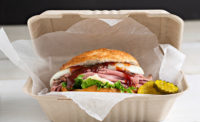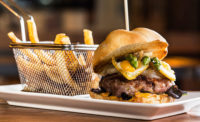More than half of Americans (54 percent) say their typical weekday lunch is leftovers from home, but nearly as many (48 percent) say they enjoy a homemade sandwich with meat, according to Chicago-based Mintel International’s Bacon and Lunch Meat – US - October 2016 report. One in five consumers (21 percent) say they eat a salad with meat they made at home for lunch. In addition, refrigerated/frozen entrées, such as Lean Cuisine and Healthy Choice, account for 17 percent of consumers’ choices at lunch, while 9 percent say they eat refrigerated or frozen pre-made sandwiches, such as Oscar Mayer Deli Creations or Lean Cuisine Panini, at lunch.
The NPD Group, Chicago, also finds sandwiches are a top lunchtime entrée for meals made at home. “We don’t want to spend a lot of time at lunch, so more than 60 percent of our lunches are prepared in less than 10 minutes,” says Darren Seifer, NPD’s food and beverage industry analyst. “A sandwich fits that bill.”
Looking specifically at sandwiches, peanut butter and jelly ranks first, followed by ham and turkey. A chicken sandwich comes in ninth place among NPD’s Top 10 sandwiches, but poultry ranks No. 7 overall as a top entrée prepared at home.
While sandwiches have been the top lunchtime choice for a while, what is changing is the increase in non-meat sandwiches, such as a cheese sandwich, Seifer says. Salads, pizza, frozen entrées, mostly driven by frozen sandwiches, and Mexican dishes are all growing at lunchtime as well, he says.
A continued emphasis around fresh foods at lunchtime and throughout the day is a big reason why salads, which could be made with or without meat, are the No. 1 growing item at lunchtime. “Adults less than 40 have been consuming more fresh foods compared to that same age group 10 years ago,” Seifer says.
Poultry and meat can play a part in the fresh trend, by emphasizing fresh products that didn’t come frozen or some other preservation method that would suggest the product isn’t fresh, he adds.
Lunch meat, whether bought freshly sliced from a deli or prepackaged, is primarily used to make sandwiches at home, Mintel reports. For all day parts, free-from claims among lunch meats haven’t resonated strongly with consumers, but 25 percent do show interest in low-sodium options, with one in six preferring hormone-free forms. Lunch meats are promoting a slew of popular free-from claims though, including fat free, gluten free, GMO free, and low in nitrates and nitrites, the research firm says.
Claims may not be popular yet for lunch meats, but 27 percent of consumers did show interest in buying lunch meat options for restricted diets, such as low fat, low sodium and low cholesterol, Mintel reports. One in five consumers also said they would be interested in purchasing lunch meats free of allergens. The research firm thinks consumers clearly recognize the need to incorporate protein into their diets, and lunch meats can leverage something of a healthier perception while also delivering a cost-effective option.
Speaking to the popularity of sandwiches, when NPD asked people what motivated the different meal occasions, portability and not much else skews high at lunchtime. In regard to health, about half of adults say they want more protein in their diet, Seifer says. “Dinner is typically when we get the bulk of our protein throughout the day, so perhaps there is some opportunity to shift that to another day part,” he says.
Deli steps up convenience
The deli section of retail stores knows convenience is key if it wants to sell products. Consumer research in the Food Marketing Institute’s Power of Fresh Prepared/Deli report, supported in Nielsen data, shows retailers have an opportunity to up their presence and assortment for the lunch crowd.
“Overall, shoppers value the deli prepared section of the store for its speed and convenience, and with an hour or less for lunch this could be a great option for shoppers,” says Sarah Schmansky, director of Nielsen Fresh. “Yet only 35 percent of shoppers surveyed think about the deli prepared section as an option sometimes. Forty-one percent hardly ever think of it as an option, and 23 percent never think of deli prepared as a lunch option.”
Urban shoppers, though, are twice as likely to buy deli prepared options for lunch regularly, at 11 percent vs. 6 percent overall, the Power of Fresh Prepared/Deli report shows.
Schmansky expects retailers to continue to put more emphasis on their ability to serve the lunchtime crowd whether it’s through quick and convenient offerings or sit-down areas. “Making it easy and quick is key to capturing this consumer,” she says. “Research shows that fast casual and quick-service restaurants are seen as the closest competitor to deli prepared offerings in price and quality.”
In turn, retailers are mimicking fast-casual and quick-service restaurants with emphasis on preparation, quality food and customization with better-for-you ingredients. Hot bars, salad bars, soup stations, as well as grab-and-go offerings such as deli sandwiches, pizza slices, etc., attract the time-starved consumer as well, Schmansky says.
Getting consumers to think about the retail store as a lunch option is the first step and having chef-inspired, high-quality recipes and options to rival restaurant trips is imperative, she adds.
Restaurants take on trends
Mintel reports 22 percent of consumers eat out for lunch and 21 percent order take-out from a restaurant. Consumers’ most preferred lunch entrées are burgers (71 percent on weekday and 68 percent on weekend), sandwiches (67 percent on weekday and 61 percent on weekend) and pizza (62 percent on weekday and 58 percent on weekend), according to Chicago-based Technomic’s Lunch Consumer Trend Report. Chicken entrées (61 percent on weekday and 58 percent on weekend) ranked as the fourth most popular lunch entrée.
Of chicken entrees measured, consumers are most likely to order chicken strips; boneless, skinless chicken breast; rotisserie chicken or fried chicken at lunch, says Anne Mills, Technomic’s manager of Consumer Insights. Among beef entrées measured, consumers are most likely to order a Mexican entrée with beef, steak pasta dish or soup/chili with beef at lunch. Among pork entrées measured, consumers are most likely to order barbecued pork, pulled pork, pizza topped with pork or pork ribs at lunch.
Among Top 500 restaurant chains, most entrées have slightly decreased on lunch menus from first quarter 2016 to first quarter 2017, including burgers as well as chicken, beef and pork dishes, according to Technomic’s MenuMonitor database. But, more Top 500 chains are now including on their menus Asian chicken (up 11 percent), fried chicken (up 4.9 percent) and barbecue chicken (up 4.3 percent) compared with the first quarter of 2016. Also, more Top 500 chains are offering beef flank/medallions/tips (up 10 percent) vs. first quarter 2016.
Handhelds, namely burgers and sandwiches, and salads serve as the core for most lunch menus, and the top menued proteins reflect these key item types, Datassential, Chicago, reports. Chicken is the most popular lunch protein by far, with 71 percent of non-ethnic lunch menu penetration, the research firm says. Specifically, grilled chicken (33 percent) and fried chicken (17 percent) are among the top menued proteins. Beef (43 percent), bacon (43 percent), turkey (42 percent), and ham (31 percent), round out the top menued proteins on non-ethnic lunch menus.
Datassential finds a number of trends are playing a role on today’s lunch menus, including increasingly blurred day part hours, all-day snacking and a greater focus on premium offerings. From limited-service restaurants’ all-day breakfast menus to the popularity of brunch at fast-food restaurants, more breakfast dishes are appearing at lunch as well as bold afternoon and evening proteins growing more acceptable before noon. The result is dishes that blur the line between breakfast and lunch are turning up in either day part. Some examples: pulled-pork benedict, short rib hash, fried chicken and waffles, and breakfast burgers.
Technomic agrees that the trend for all-day breakfast is contributing to more breakfast offerings, such as breakfast sandwiches, at lunch. “Breakfast offerings may cannibalize sales of traditional lunch options,” Technomic’s Mills says.
In addition, consumers are increasingly ordering pork for lunch, which is likely due in part to more breakfast offerings being offered at lunch. Technomic’s Center of the Plate: Beef & Pork Consumer Trend Report found that 62 percent of younger consumers ate pork for lunch on an at least weekly basis in 2016, up from 49 percent in 2014. Technomic believes the increase may be due to the growth of trendy pork lunch dishes, such as pork belly tacos and pulled-pork sandwiches.
Newer concepts — such as artisan butcher shops, food halls and modern luncheonettes — bring added focus toward quality, using premium meats and ingredients, Datassential says. Menus at these establishments trend forward from ethnic inspired dishes to more unusual proteins, such as charcuterie lunch boards, duck sandwiches and lamb burgers. Inspired by more innovative lunch menus, Starbucks rolled out a new lunch menu this month to Chicago-area locations. The “Mercato” menu features ingredients including cage-free eggs and poultry raised without antibiotics, in ethnic inspired dishes, like Za’atar Chicken and Lemon Tahini Salad, Honey BBQ Sriracha Chicken Sandwich and a Cubano featuring smoked pork.
With busy workday time constraints, lunch consumers need the flexibility to order and eat their food in the most convenient way, according to Technomic’s Lunch Consumer Trend Report.
“Convenience and fast service is key as consumers often have a short amount of time for weekday lunches,” Mills says. “About four in 10 lunch occasions are carryout, underscoring the importance of portability.”
Operators are responding in a variety of ways to convenience demands, from time guarantees to pre-packaged boxed lunches and value bundles to afternoon snacking options, Datassential says. For example, nearly all operators’ menu items that can be considered “snackable,” according to Datassential’s MenuTrends Keynote on Snacking report. These items are most commonly on lunch menus, declining dramatically in later day parts.
The majority of operators with menus that feature various snackable items say they are profitable. For instance, at Underbelly in Houston, the lunch menu states, “No ‘appetizers’ or ‘entrees’ – just food. We recommend ordering several, and passing them around.” Offerings include the house Charcuterie, Korean Braised Goat and Dumplings and Crispy Pork Schnitzel. At Cannibal, an artisan butcher shop in New York City, the lunch menu features a “Snacks” section with Beef Jerky, Beef Tartare Crumpets and Reuben Egg Rolls, while also featuring items such as the Pig’s Head Cuban sandwich, among their full lunch “Plates.”
Technomic also reports snack consumption is on the rise, causing a shift to patrons’ lunch behaviors. For example, 46 percent of consumers consider eating afternoon snacks to be skipping lunch, the research firm found.
While delivery only accounts for 1 in 10 lunch occasions, 33 percent of consumers at least somewhat agree they’re ordering from third-party delivery services more in 2016 than they were in 2014, Technomic reports.
“Restaurants are investing in delivery programs and third-party delivery partnerships in order to boost sales, including lunch sales,” Technomic’s Mills says. “While this means there’s more opportunity to grow sales of meat and poultry dishes, it’s essential to maintain the taste, quality, texture, etc., of dishes.”
Mills also expects to see more fresh vending, such as Farmer’s Fridge in the Chicago area, which will provide an additional lunch touchpoint. “The convenient and speedy format is ideal for lunch occasions,” she says.
Food transparency and clean ingredient labels are increasingly important to consumers and operators and will continue to play a role in all day parts, Datassential adds. For proteins, this means descriptors such as grass fed, organic, cage free, local, hormone and antibiotic free are on the rise.
Premium meats with enhanced descriptors, including point of origin, and specialty meat cuts, increasing ethnic influence along with the continued popularity of Southern and barbecue cuisine, are driving growth for a number of proteins at lunch, Datassential finds. Pork varieties are growing, including pork shoulder (up 206 percent), pork belly (up 59 percent), pepper bacon (up 53 percent) and pulled pork (up 28 percent) among non-ethnic lunch menus. Chicken is experiencing a bit of a renaissance with the renewed popularity of fried chicken sandwiches and chicken and waffles, while buttermilk chicken (up 189 percent) has shown lots of recent growth, the research firm says. Charcuterie and deli proteins such as capicola (up 85 percent), mortadella (up 34 percent) and prosciutto (up 21percent) are also on the rise on non-ethnic lunch menus. Other notable growth proteins include, short rib (up 66 percent), Kobe beef (up 47 percent), brisket (up 39 percent), chorizo (up 31 percent) and lamb (up 14 percent) on non-ethnic lunch menus.
Technomic’s Mills agrees that general industry trends, including healthier, additive-free foods (e.g., antibiotic-free chicken and fresh beef), ethnic flavors and twists on traditional dishes, spicy and hot fried chicken, and fast-casual barbecue are relevant at lunch.
As far as innovation, artisan butcher shops bring a “butcher-to-table” approach, with in-house smoked and cured meats or house-made sausages, allowing for lots of non-traditional offerings such as duck bacon or venison sausage, Datassential says. Food halls are another source of innovation for lunch menus, offering customization and personalization in a fast-casual setting, according to Datassential’s Creative Concepts-Food Halls publication.
Modern Luncheonette menus also feature revamped, or elevated, classics with a renewed emphasis on quality in a familiar, casual environment. Menu simplicity also is growing with high-quality ingredients including locally sourced and organic proteins and vegetables, Datassential says.
Unique proteins, such as venison, duck, pork belly, bison and lamb, are growing beyond innovative independents as well. More familiar proteins also are finding continued growth, like fried chicken, pulled pork and brisket, due to the renewed popularity of Southern and barbecue trends, which shows no signs of slowing down, Datassential says.
Also, embracing ethnic influence will continue to grow moving forward. Ethnic dishes and mashups continue to be a source of innovation on menus, from unique protein offerings in a familiar way, such as a burger with pork belly, or a familiar protein in a less familiar ethnic format, such as an antibiotic-free chicken torta. Core lunch items, including burgers and sandwiches, serve as a perfect platform for introducing global and non-traditional flavors in a familiar way with lots of continued growth potential, Datassential says. NP







Report Abusive Comment